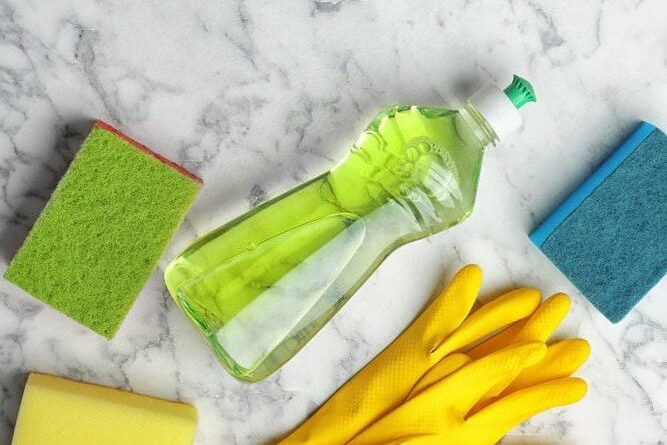11 Things in Your House You Should Avoid Cleaning with White Vinegar and Baking Soda
One of the most popular cleaning hacks you’ll see online, and that’s promising to make your domestic life easier, is to combine white vinegar with baking soda or use each of them separately for cleaning. True, white vinegar can do almost anything when it comes to cleaning and can easily be found in anyone’s kitchen cupboard. Together with baking soda, they are the ideal combination to tackle any cleaning chore you have in mind. This hack is perfect for anyone looking to save time and have a cleaner home.
What You Shouldn’t Clean With Vinegar and Baking Soda
Despite the many benefits of white vinegar as a cleaner, its high acidity can cause damage to certain materials, so it shouldn’t be used to clean those items. The gritty texture of baking soda can wreak havoc on certain surfaces – think of it as an abrasive version of sandpaper. These are the 11 things you shouldn’t clean with white vinegar to avoid damage and save up on extra costs:
Marble and Granite Surfaces
The acidic properties of white vinegar can wear away the natural stone surfaces of marble and granite countertops and/or tiles. The use of baking soda on marble or granite can lead to discolouration and dull the glossy finish. Over time, the top protective layer will be damaged, resulting in unsightly scratches on the surface. These natural stone surfaces may seem pricey, but trust us – they’ll cost you even more if you take advantage of this “cleaning hack”!
Waxed Furniture
One should be aware of the surface they are cleaning when applying the cleaning advice found online, which often suggests using white vinegar on furniture and dining tables. If you use a lot of white vinegar to clean waxed furniture, you’ll be left with nothing but a dull shine – and a broken heart. Baking soda may be too harsh for some finishes or coatings on wooden furniture, potentially causing it to wear away. It’s advisable to purchase a wood cleaner that’s been specially designed for cleaning wood.
Hardwood Flooring
White vinegar’s acidic properties can remove the glossy sheen from hardwood floors, while baking soda is capable of eroding the sealant that is applied to wood floors. For the safety of your floor, opt for a more gentle cleaning approach, such as warm water and soap or a speciality hardwood floor cleaner. Be wary not to put too much of it or leave it for too long, as this can warp the flooring.
Kitchen Knives
Wondering why your knives aren’t as sharp as you’d like? If you’ve been using vinegar to clean your utensils, it might be time to face the facts – white vinegar is just too acidic for metal blades. So, if you want to keep your knives in good shape, just stick to warm water and soap and make sure to dry them off. Trust us – vinegar’s acidity isn’t something to be taken lightly. It’ll corrode metal and dull your knives faster than you can say, “cheddar, please!”
Egg Stains
Vinegar might be an egg-cellent cleaner, but not for eggs! White vinegar’s acidity will only stiffen the egg substance instead of cleaning it. It’ll even become more difficult to remove. Mix two teaspoons of liquid dish soap with two cups of cold water for a simple way to remove an egg stain. You can also try using a clean, dry cloth or sponge to apply the solution and then blot the area with a paper towel.
Electronic Screens
White vinegar is a great cleaner for many surfaces, but it will quickly strip the protective layer off of the surfaces of electronic devices if used incorrectly. For these types of surfaces, it’s best to use a microfiber cloth and specially formulated cleaner for electronic screens.
Rubber Items
The strong acidity of white vinegar can really take its toll on the rubber seals of your fridge, washing machine, or other type of appliance. Over time, the material will deteriorate, and you’ll end up with higher bills as your appliances use up more energy. So, if you want to give them a good clean, baking soda is the way to go – just make sure to dissolve it in warm water, not white vinegar!
Glass
Yes, glass! Baking soda may be a powerful cleaner, but no one wants a scratched window or mirror! Stick to the tried and true glass and hard-surface cleaners, or get creative and use vinegar on its own. Just don’t combine the two – it could be a recipe for disaster!
Gold- or Silverware
It’s a common practice to submerge your gold- or silverware in water and baking soda to remove tarnish. Nevertheless, because of the mixture’s abrasiveness, the patina and discolouration may occur at an earlier stage.
Clothes Iron
Adding vinegar to the tank of a clothes iron to clean it can cause permanent damage to the inside of the appliance. Because of its acidic nature, it can corrode the lining of the protective coating, which can then harm the metal parts of your iron.
Aluminium and Copper
Baking soda can cause aluminium and copper surfaces to oxidise, and extensive contact will turn them brown. It’s okay to clean your pots and pans with baking soda, but it’s important to rinse them thoroughly right after. Avoid using baking soda on small kitchen appliances, as the metal used for them is usually of lower quality and can get damaged quicker. To clean them, it’s best to stick to vinegar only.
Final thoughts
In conclusion, while white vinegar and baking soda can be effective cleaning agents for many surfaces in your home, it’s important to choose your battles wisely. Exercise caution and be mindful of what you clean with these products to prevent any damage and ensure your items will live to see another day. Remember that there are alternative cleaners specifically designed for delicate surfaces like marble or granite countertops, as well as specialised solutions for electronics and appliances. So next time you reach for that trusty bottle of vinegar or box of baking soda, consider the potential consequences on the item at hand – because sometimes, natural cleaning needs a little restraint. Go forth and conquer your household chores with wisdom and an understanding of which items should stay away from these beloved ingredients. Happy cleaning – may your surfaces live to be sparkling clean!

